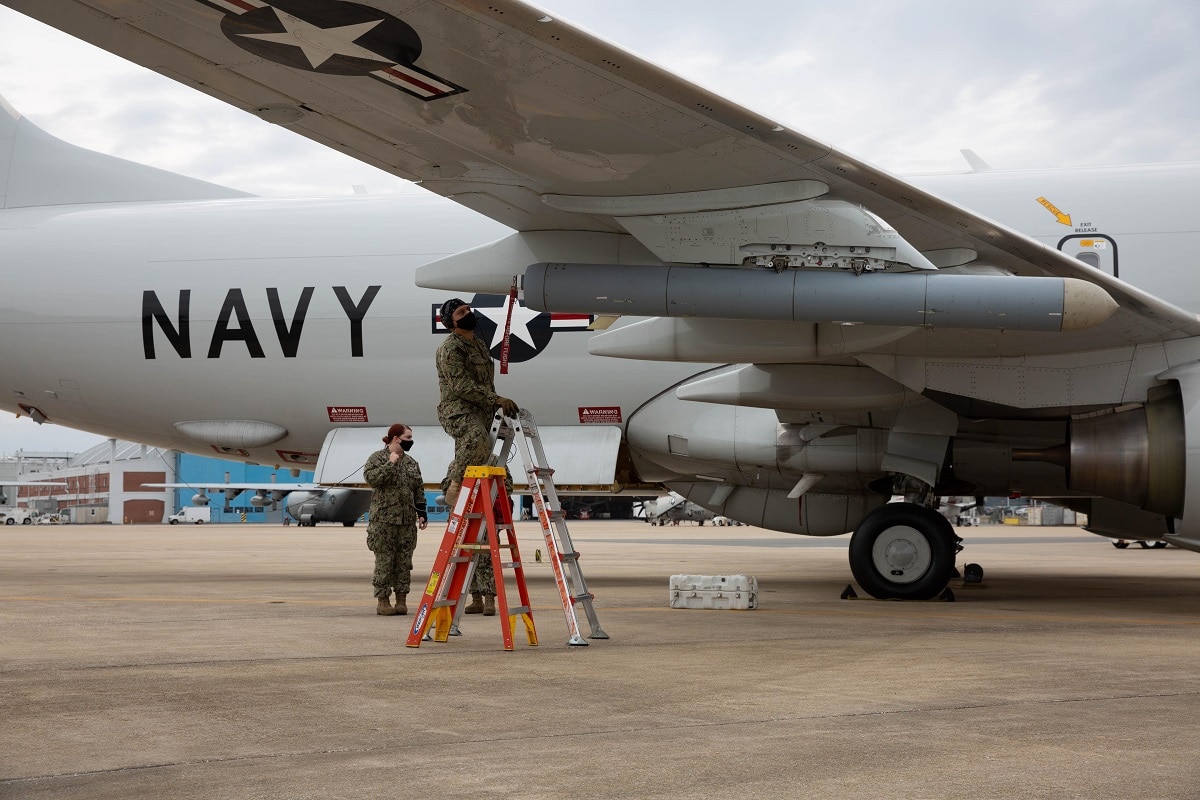Following the test, the pod went to Naval Air Weapons Station China Lake, California where it successfully completed effectiveness testing, March 21-26. It will now continue to be tested at a system level leading to platform integration through planned capability fielding phases. (U.S. Navy photo)
An Air Test and Evaluation Squadron (VX) 20 P-8A Poseidon maritime patrol aircraft (MPA) successfully completed an airworthiness test of a pod-mounted radio frequency countermeasure (RFCM) prototype at the Naval Air Warfare Center Aircraft Division (NAWCAD) Atlantic Test Ranges, March 12.
Naval News Staff 10 Apr 2021NAVAIR press release
The first-of-its-kind radio frequency defense decoy could allow the P-8A to thwart enemy radio frequency missile attacks.
“This has the potential to be a game-changer for protecting the warfighter,” said. We continue to look for ways to enhance capabilities that allow the fleet to be successful.”
Capt. Eric Gardner, program manager for the Maritime Patrol and Reconnaissance Aircraft Program Office (PMA-290)
Getting the pod into testing, in just over a year, took a complete team effort.
Constantly looking for upgrades to the P-8A, PMA-290 set out to find a solution to a potential threat from surface-to-air radio frequency missiles.
Outlining their needs and running lead on the project, PMA-290 brought in the Advanced Tactical Aircraft Protection Systems Program Office (PMA-272), the Rapid Prototyping, Experimentation & Demonstration (RPED) team, and the NAWCAD Aircraft Prototype Systems Division (APSD) to get the ball rolling.
A member of Air Test and Evaluation Squadron (VX) 20 puts a pod-mounted radio frequency countermeasure system on a P-8A Poseidon, March 12. The pod successfully competed an air worthiness test at the Naval Air Warfare Center Aircraft Division (NAWCAD) Atlantic Test Ranges. (U.S. Navy photo)
The RPED team supported APSD in designing the RFCM pod, which integrated the proven AN/ALE-55 Fiber Optic Towed Decoy from PMA-272 into a shell. The team developed the shell design based on the certified AGM-84 Harpoon missile, and then incorporated unique tracks and housing to fit and deploy the decoy.
By employing the assistant secretary of the Navy for research, development and acquisition’s delegation of other transactions authority (OTA) for prototype projects, PMA-290 and NAWCAD were able to complete a one-of-a-kind contract with BAE Systems to develop the RFCM pod’s additional internal equipment suite. The OTA, a non-Federal Acquisition Regulation contracting approach, could potentially allow this critical self-protection technology to transition from prototype to fleet capability in much less time than a traditional effort.
APSD and BAE leveraged the established AN/ALE-55 electrical design to accommodate the suite’s installation.
“A lot of the challenge and effort went into designing, to our best estimates, for what BAE was expected to put in the pod,” said Michael Hansell, the leading APSD engineer for the project. “We had to adapt and redesign rapidly. We worked as fast as possible to support PMA-290 and RPED to make sure we could pivot and adjust to meet established timelines.”
Constant tweaks were needed as the teams continued to hone in on a capable design.
“Michael Hansell and his team’s flexibility and willingness to go above and beyond, to work through issues and prepare for BAE, was key in getting [the pod design and build] done in a timely manner,” said James Sherman, the APSD project lead.
The Naval Innovative Science & Engineering (NISE) program funded the project, which provided the means to conceptualize, prototype, build, and test this new capability for the Navy.
This funding accelerated the design and manufacturing cycle for the prototype to just under six months. The expedited developmental process supports the rapid prototyping of new and developing technologies and provides the resources to find solutions and incorporate improvements to fill capability gaps in the fleet faster.
The teams were also able to utilize PMA-272’s F/A-18 lab equipment to speed up the timeline.
All this teamwork culminated in the successful airworthiness test with VX-20.
“This shows that when we identify a need and work rapidly as a team we can bring a viable solution to test that has the ability to greatly impact the warfighter,” said Lt. Cmdr. Mike Marschall, PMA-290 weapons and rapid capabilities co-team lead.
Following the test, the pod went to Naval Air Weapons Station China Lake, California where it successfully completed effectiveness testing, March 21-26. It will now continue to be tested at a system level leading to platform integration through planned capability fielding phases.

US Navy Completes Airworthiness Test of Pod-Mounted Towed Decoy for P-8A MPA - Naval News
An Air Test and Evaluation Squadron (VX) 20 P-8A Poseidon successfully completed an airworthiness test of a pod-mounted radio frequency countermeasure (RFCM) prototype...

